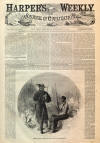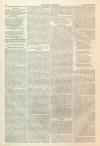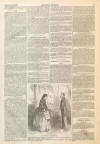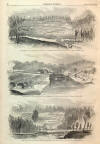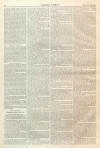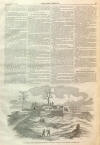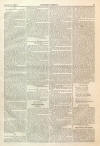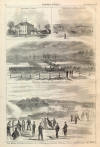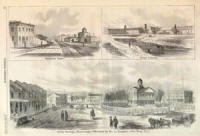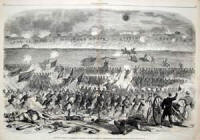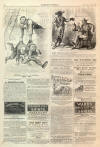The Battle of Fredericksburg
|
|
This Site:
|
VOL. VII.—No. 315.] NEW YORK, SATURDAY, JANUARY 10, 1863. SINGLE COPIES SIX CENTS. $3.00 PER YEAR IN ADVANCE. Entered according to Act of Congress, in the Year 1862, by Harper & Brothers, in the Clerk's Office of the District Court for the Southern District of New York. REBEL NEGRO PICKETS.So much has been said about the wickedness of using the negroes on our side in the present war, that we have thought it. worth while to reproduce on this page a sketch sent us from Fredericksburg by our artist, Mr. Theodore R. Davis, which is a faithful representation of what was seen by one of our officers through his field-glass, while on outpost duty at that place. As the picture shows, it represents two full-blooded. negroes, fully armed, and serving as pickets in the rebel army. It has long been known to military men that the insurgents affect no scruples about the employment of their slaves in any capacity in which they may be found useful. Yet there are people here at the North who affect to be horrified at the enrollment of negroes into regiments. Let us hope that the President will not be deterred by any squeamish scruples of the kind from garrisoning the Southern forts with fighting men of any color that can be obtained. THE BATTLE OF FREDERICKSBURG.ON pages 24 and 25 we publish an illustration of GENERAL HUMPHREYS'S MAGNIFICENT CHARGE AT THE BATTLE OF FREDERICKSBURG, from a sketch by Mr. A. R. Waud. We have heretofore published accounts of the battle, and will only subjoin here Mr. Waud's account of the charge : "The strength of the rebel position at Fredericksburg has been described a number of times; it was, in short, a natural fortress of the most formidable character. Their guns were mounted along the crest of a steep hill, which formed a glacis sloping to the plain below, across which our troops had to charge. Along this glacis or slope runs a road in-closed by stone walls. Against the inside of these walls earth had been shoveled, and then covered with boards for the riflemen to lean on. Here, four ranks deep, they securely leveled their deadly weapons on our column,. In addition to this fortified road rifle-pits covered the hillside in all directions. "Against this magnificent defensible position, strong as Sebastopol, and more dangerous for an attacking force on account of the river in its rear, our troops were hurled all day. To what purpose all know now. The place was impregnable! French and Sturgis led their divisions with patriotic determination to the enemy's rifle-pits. Sturgis, suffering severely, held his ground, as it were, under the muzzles of the heavy batteries. French's column, shattered, broken, falling by hundreds, advancing still with heroism unparalleled, delivered its fire till the last cartridge was spent and nearly half its men killed and wounded. It retired as it came—over the open fields. After it came first Hancock's and then Howard's divisions, each charging more savagely than it predecessors, and holding the ground in front of the rebel works, while its ammunition lasted. By this time the sun had set behind the rebel fortifications. The crimson edged clouds gleamed luridly through masses of smoke, which almost obscured at times the placid sky, so peaceful in its quiet evening tints, and suggestive of the cessation of the day's labor. Not for the army, however, did it indicate repose. The rebel fire breaks out with more ferocity than ever. For sweeping across the fields come the divisions of Generals Humphreys and Griffin. Onward, a forlorn hope, they advance—the ground encumbered by the countless bodies of the fallen; knapsacks, blankets, guns, haversacks, canteens, cartridge-boxes, etc., strewed all over the plain. Shot, shell, canister, shrapnel, and grape is hurled as they approach. By column of regiments, led by their generals, and without firing a shot, that noble band continues on. General Humphreys, dashing ahead to a small rise in the ground, takes off his hat to cheer on his men. With reckless ardor his men, rapidly closing on the double-quick, answer cheers with cheers. Every member of the General's staff has been dismounted. The brave Humphreys himself has two horses shot under him. Here a strange thing occurs. Howard's division, lying on the ground and holding their position with the bayonet since their ammunition was expended, opposes the advance of the division of Humphreys. With pistol and sword the officers threaten and prevent the passage of another division over their prostrate lines, thereby throwing the advancing column into confusion —a confusion which may have prevented this, the last effort of the army, from being successful, for through the smoke the rebels are seen running from the wall. "Humphreys's division has never been under fire till this battle. But before that awful hurricane of bullets no heroism can avail. The hillside appears to vomit forth fire, its Leven glare flashing through the fast - thickening obscurity seems to pour with redoubled power upon our storming columns, till, being unable to stand up against it longer—although within eighty yards of the wall—the brave remnant, singing in the abandon of its courage, marches steadily back to the place where it formed for the charge, leaving its comrades in swathes upon the bloody ground, where, ' stormed at by shot and shell,' they had been cut down, whole ranks at a time, by that terrible fire. " Thus closed the battle, except for now and then the boom of a heavy gun from the heights and the constant sharp report of the rifles of the sharp-shooters. But the horrors of that night—the scenes of despair and gradual death upon that bloody ground in the bitter cold and darkness—can not be described. Imagination recoils from the cruelty of the scene.' No help for the dying patriots on that awful night. To attempt to reach them was to share their fate. The murderous traitors, without remorse, shot down all who approached. Men with children dependent on them —men whose wives trembled for them—men who had been little children, and whose mothers would have feared to have a cold wind blow on them—there they lay. Of no avail affection ; not for them the soothing touch, the warm chamber, and the thousand nameless attentions of kinsfolk. Drearily and with faint hope for the morrow, tired, bleeding, dying, they, must stay, their noble efforts icily wasted in a fruitless struggle." On page 28 we publish several pictures of the Fredericksburg affair, from sketches by our special artist, Mr. Theodore R. Davis. One of these represents GENERAL FRANKLIN'S GRAND DIVISION RECROSSING THE RIVER AFTER THE BATTLE ; an- other shows us the SKIRMISHERS DEPLOYED TO COVER THE RETREAT—some of them lying, others crouching behind every little hillock, or log, or stone which could serve as a protection against shot or shell, others exposing themselves more fully ; another, OUR ARTILLERY FIRING UPON THE ADVANCING COLUMNS OF THE ENEMY to keep them at a respectable distance ; and another, showing us THE House: or A. H. BURNARD, which was used by General Franklin as his headquarters during the fight. It was in the grounds adjacent to this house, and within fifty yards of the door, that the gallant General Bayard was killed. The following excellent account of the charge of Humphreys is from the World correspondence: Humphreys's division of Butterfield's corps was resting on its arms in the streets of Fredericksburg. General Butterfield sent an order to move it to the front.; simultaneously Hooker ordered Hazard and Frank to take their batteries to the crest which our infantry had made their fighting line all the day long; to open rapidly, and concentrate their fire upon a certain point in the stone wall. This was a perilous undertaking, but it was executed in a most gallant manner. Hazard was at once in position, though losing sixteen men and eighteen horses before he fairly begun. Frank followed, took up a position farther to the left on the same line, and then both batteries opened with shell and solid shot at a range of only two hundred and seventy-five yards. While their cannonade was going on Humphreys, at the head of Allabach's second brigade, had crossed the mill-race, and was forming his men behind the crest ready for the charge, and Tyler's first brigade was following closely after, ready to support. The line was formed, the column moved gallantly forward, reached the line of battle, passed fifty yards beyond, when a deadly fire from behind the stone wall caused it to recoil, and finally to fall back, reforming under the crest from which it started. Humphreys and staff, and many other field-officers, were dismounted in this charge, their horses being killed, while the brigade lost five hundred men in fifteen minutes. Now there was but one more chance. Tyler's brigade had come up, and notwithstanding the turmoil, General Humphreys had succeeded in forming it in gallant style. The only hope now was with the bayonet. The men were ordered not to fire —to rely solely upon their trusty steel. Then, with great exertion, the batteries and the lines of troops on the crest were persuaded to cease firing while the charge was being made ; then General Hooker exhorted his men not to quail, not to look back; to disregard the men in front who were lying down, covered by every projection; to ride over them. The officers were ordered to the front; then the brigade, led in person by General Tyler and General Humphreys, moved forward with a glorious cheer. They reached the little rise in the ground, within eighty yards of the stone wall, where line after line of our men lay flat upon the ground: they began to move over the living mass, when suddenly the prostrate men cried out, " Don't go there, 'tis certain death!" and, rising, began to impede the progress of the column, and by protesting of every nature implored the men not to go forward. Then the crisis came. The division was fighting its maiden battle; older troops than they quailed before the murderous volleys now making-great gaps through their ranks ; the head of the charging column was enveloped in a sheet of living flame; the hideous shells were bursting all around and in their midst. Was it any wonder that they faltered? The men began to load and fire; the momentum of the charge was gone; the column began to retire slowly, falling back to its place of formation. "Oh ! men," said Humphreys, "if you had only gone forward as well as you came back!" And then, again dismounted, his second horse having been killed, he reported the result to General Butterfield, who ordered him to withdraw his troops to a point of shelter. And this was the forlorn hope of the day, and this is what it did : it demonstrated the impregnability of the enemy's positions- demonstrated that the bravest troops in the world could not stem the torrent of fire which poured and plunged and converged into that fatal space, and it developed a quiet, courteous, and accomplished man of science with whom books, and charts, and surveys have been his studies, into a splendid field general of unmatched bravery. REBEL NEGRO PICKETS AS SEEN THROUGH A FIELD GLASS 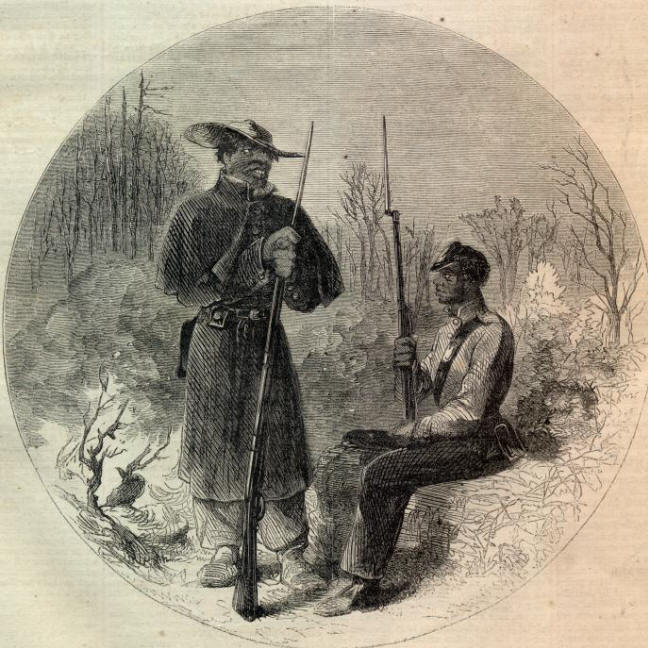 We acquired this leaf for the purpose of digitally preserving it for your research and enjoyment. If you would like to acquire the original 140+ year old Harper's Weekly leaf we used to create this page, it is available for a price of $195. Your purchase allows us to continue to archive more original material. For more information, contact paul@sonofthesouth.net |
||||||||||||||||||||||
|
|
||
|
|
Site Copyright 2003-2018 Son of the South. For Questions or comments about this collection, contact paul@sonofthesouth.net |
|
|
Are you Scared and Confused? Read My Snake Story, a story of hope and encouragement, to help you face your fears. |
||
